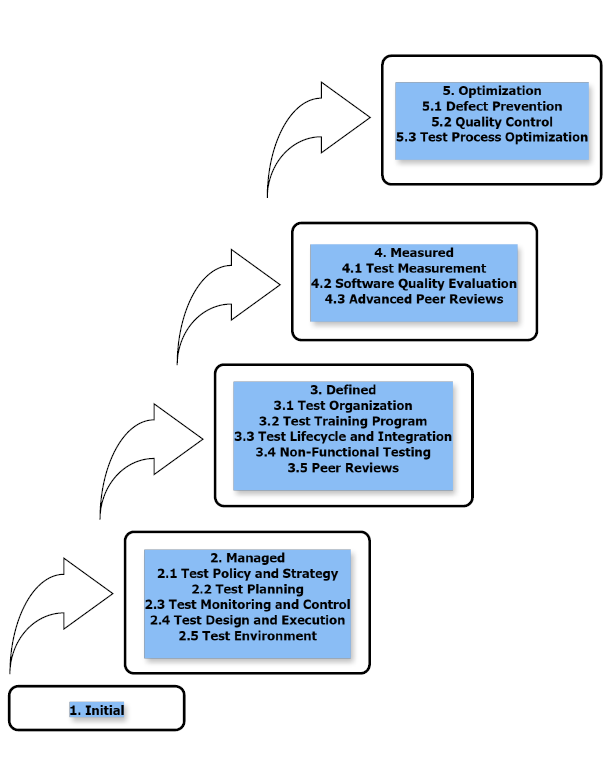Bridging Methodologies - Navigating the Challenges of Integrating TMMi (Test Maturity Model integration) into Agile and Scrum Environments
December 2 2023
The Test Maturity Model integration (TMMi) is a model used to improve test processes, similar to the CMMI ( Capability Maturity Model Integration) framework used in software development. TMMi aims to help organizations enhance their testing processes and achieve higher quality software products. However, integrating TMMi into Agile and Scrum processes can present several challenges.

Challenges of Integrating TMMi into Agile and Scrum
Philosophical Differences
Agile methodologies, including Scrum, emphasize flexibility, rapid iterations, and adaptability. They prioritize working software and customer collaboration over comprehensive documentation and contract negotiation. In contrast, TMMi is a structured model that requires detailed documentation and defined processes. This fundamental disparity can cause resistance, as integrating TMMi may seem counterintuitive to core Agile principles.
Perceived Rigidity
TMMi's structured levels and practices may appear rigid, conflicting with the Agile value of responding to change rather than following a plan. Adapting TMMi within an Agile framework requires careful consideration to ensure that process improvements do not undermine the team's agility.
Documentation and Procedure Overhead
TMMi practices often necessitate detailed documentation and strict adherence to specified procedures. For Agile teams accustomed to minimal documentation and quick iterations, this can introduce significant overhead, potentially slowing processes and impacting morale.
Continuous Integration/Continuous Deployment (CI/CD) Conflicts
Aligning TMMi with CI/CD practices poses another challenge, as TMMi was not explicitly designed with these automated, dynamic systems in mind. Integrating structured test process improvements within CI/CD pipelines requires innovative solutions to maintain efficiency and effectiveness.
Emphasis on Measurement and Metrics
TMMi places significant importance on measurement and metrics to drive process improvement. In Agile environments, where the primary focus is quick delivery of customer value, the extensive metrics collection recommended by TMMi might clash with team priorities or workflows.
Scalability and Adaptability
TMMi, originally more suited to larger, traditional software development environments, may pose scalability and adaptability challenges for smaller Agile teams. Adapting and scaling down TMMi practices to fit a more fluid and fast-paced Agile environment requires thoughtful customization.
Mitigating the Challenges
Tailored Implementation
Organizations should adapt TMMi practices to fit within the Agile framework selectively. Focus on those practices that add the most value to the team's processes without compromising agility. This might include prioritizing defect prevention and early testing.
Gradual Integration
Start with TMMi practices that naturally complement Agile principles and integrate more practices gradually. This approach allows the team to adjust and align with TMMi methodologies without overwhelming the Agile process.
Focus on Quality and Customer Satisfaction
Prioritize TMMi practices that directly contribute to improving product quality and customer satisfaction. Ensure these practices align with the Agile focus on delivering customer value efficiently.
Involvement and Feedback
Engage development and testing teams in the integration process. Allow them to suggest adaptations that fit their workflows while still achieving the goals of TMMi. Utilize Agile retrospectives and feedback loops to continuously assess and refine the integration of TMMi practices.
Strategic Balancing
Integrating TMMi into Agile and Scrum processes requires a strategic balancing act. Ensure that the structure and discipline of TMMi enhance rather than hinder the flexibility and speed of Agile methodologies. With thoughtful adaptation and a focus on value, organizations can navigate the challenges and leverage the strengths of both approaches to enhance software quality and testing processes.
Conclusion
Integrating TMMi into Agile and Scrum environments is not without its challenges, but with the right strategies and adaptations, it can significantly enhance software quality and efficiency. By understanding the inherent differences and potential conflicts, organizations can better prepare for a successful integration that respects both methodologies' strengths.
